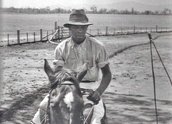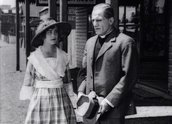


The Man from Kangaroo (1919)
Synopsis
Former athlete John Harland (Snowy Baker) is a parson on probation in a small Australian country town. When word spreads that he has been teaching local children how to box, outraged parents demand that he is removed from office. Harland leaves for Sydney, abandoning his girlfriend Muriel Hammond (Brownie Vernon) since he is too ashamed to tell her of his dismissal. In the city Harland rescues a Mr Greythorn from a mugging. Greythorn arranges for Harland to be posted to the town of Kalmaroo, where a gang led by Jack Braggan (Wilfred Lucas) has forbidden the local community to hold church services.
Harland is prepared to meet Braggan’s violence with violence but abstains when he finds Muriel among the Kalmaroo congregation. Snubbed by Muriel, Harland resigns from the ministry and becomes a farmhand. When Braggan kidnaps Muriel to force her into marrying her guardian (Charles Villiers), Harland and a posse chase the coach containing Muriel and Braggan. Harland frees Muriel, and Braggan is shot by a posse member. A closing title says of Harland and Muriel, 'So they were married’.
Curator’s notes
The Man from Kangaroo was the first of three features produced by Carroll-Baker Australian Productions, a partnership of the theatre and film showmen EJ and Dan Carroll, the Australian sportsman and film star Reg L ‘Snowy’ Baker and the Southern Cross Feature Film Co. Ltd. The initiative was spearheaded by Baker, who visited Hollywood in 1918 to re-shoot scenes for his second Australian feature The Lure of the Bush (1918). Recognising weaknesses in The Enemy Within (1918) and The Lure of the Bush, Baker wanted to ensure that his films would have international standards and appeal. Having watched American filmmakers at work, Baker and EJ Carroll contracted a team of Americans to work for them – director-actor Wilfred Lucas, scriptwriter and Lucas’s wife Bess Meredyth, cameraman Robert V Doerrer, assistant director John K Wells, and actress Brownie Vernon. Lucas had directed over 40 films, and his experience included work with DW Griffith and at Universal Studios, while Meredyth had worked at Biograph, Universal, Triangle and Kalem.
Following the arrival of the Americans on 2 September 1919, Bess Meredyth spent several days looking for Australian story ideas at Sydney’s Mitchell Library, concluding, according to Dan Carroll, 'that the only truly national subject about which Australian producers could make a picture was horse racing’. Meredyth next developed an idea given to her by Baker’s wife Ethel, resulting in the script for The Man from Kangaroo. A prime aim of the story was to showcase Baker’s trademark athletic stunts while drawing on a well-established tradition of American westerns pioneered by the likes of Tom Mix and Harry Carey.
Outback filming of The Man from Kangaroo mostly took place on Kurrumbede sheep station near Gunnedah, NSW, a location that Baker had previously used for Lure of the Bush. Like Franklyn Barrett’s The Breaking of the Drought (1920), The Man from Kangaroo was shot during a major drought. During filming of a buckjumping sequence, Baker was knocked unconscious, broke his nose, dislocated his shoulder and fractured two ribs but was back in front of the camera within hours. Three cameras covered action scenes, and Bess Meredyth, who had co-directed earlier films with Lucas, was The Man from Kangaroo’s uncredited co-director and editor. Filming also took place in Kangaroo Valley in southern NSW, where hero and heroine jumped into a river from a coach rushing across the valley’s Hampden suspension bridge. All location work was finished by the end of October 1919, when the unit returned to shoot interiors on the stage of Sydney’s Theatre Royal.
After its Sydney premiere in January 1920, The Man from Kangaroo proved popular with Australian audiences. The Port Pyrie Recorder reported of the film: 'The verdant beauty of the bush, the dust-swept areas of the scrub – you see them as they are’. Some reviewers, however, questioned the genuineness of the film’s Australian character. The Sydney Mail lamented: 'It seems a pity that so much Americanism should be injected into films that are advertised as purely Australian’. The Bulletin wrote: 'Uncle Sam soon gets in his dirty work, and the Australian story becomes starred and striped … When will we get an Australian film? Barring the Bloke pictures, they all have the flavour of chewing-gum.’
The Man from Kangaroo is today an intriguing amalgam of story ingredients, genres and performance styles, with some of its ingredients (boxing children, small town attitudes to social outcast) prefiguring John Ford’s rural American charmer, Just Pals (1920). Snowy Baker’s stunts are are peppered through a story that otherwise mixes gentle comedy, romance, woman-in-peril melodrama and suspense. Australian atmosphere, which the producers sought to bring to all their Snowy Baker films, derives mostly from the rural locations. There are charming glimpses of small-town life and its quirky characters, but there is too little of them amid an emphasis on action. Brownie Vernon demonstrates range as John Harland’s girlfriend Muriel, but in only one scene between herself and Baker – a bushland romantic scene – do the two have a chance to show the chemistry of attraction. Otherwise Baker, a performer whom most critics agreed could not act, has a tendency to look glazed in moments of repose.
Carroll-Baker’s next two films, The Shadow of Lightning Ridge (1920) and The Jackeroo of Coolabong (1920), also found Australian audience favour, and like The Man from Kangaroo, obtained American release. But for reasons that included Lucas’ alleged over-expenditure, by late August 1920 the Carrolls had ended the Carroll-Baker enterprise, and most of the American team members returned home. Snowy Baker moved to Hollywood that same month, and after starring in at least six US films from 1921 to 1924, spent most of his remaining life (he died in 1953) teaching other actors how to ride and do stunt work. Lucas continued as a supporting actor, and Bess Meredyth’s career soared with such significant writing credits as Ben Hur: A Tale of the Christ (1925), A Woman of Affairs (1928) and The Mark of Zorro (1940). In 1959-60 their son John Meredyth-Lucas worked in Sydney as a director on Whiplash, the first Australian television series produced for an international television market.
- Overview
- Curator’s notes
- Video 3 clips
- Principal credits
- Find a copy
- Make a comment
- Map
- Add your review



